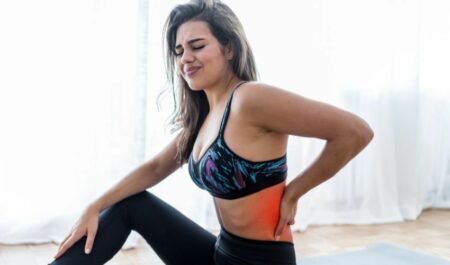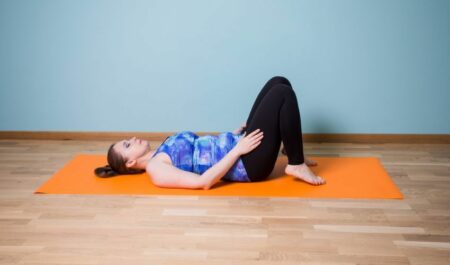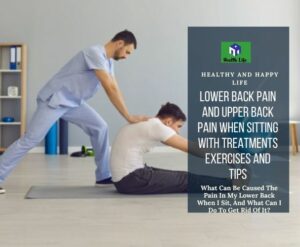Pain in the lower back can be a major problem, regardless of whether it is experienced as a stabbing, scorching pain or as a dull ache. It is something that affects the lives of four out of every five adults at some point or another. Pain in the region of the vertebrae labelled L1 through L5 is referred to as lower back pain. These vertebrae make up the portion of the spine that curves inward at the base. In here we are going to examine, what are the causes for lower back pain when sitting as well as are their methods to get rid of them.
If you sit in an awkward position for long periods of time, your back may start to suffer. When sitting in an awkward position, such as slouching or hunching over, the discs, which are fluid-filled cushions that prevent the vertebrae from grinding against one another, can experience tension.
A preexisting medical condition might make this problem even more severe. Let’s investigate the potential reasons for the back pain you get when you’re seated, as well as some solutions to the problem.

Reasons Behind Lower Back Pain Experienced When Seated.
There are many potential reasons of back pain, and not all cases of back pain are the same.
Sciatica.
A painful condition that affects the sciatic nerve, which can be found near the base of the spine and extends all the way down the back of each leg, is known as sciatica. It can be brought on by a number of different disorders, one of which being a bone spur on the spine.
A dull aching sensation or anything that seems like an electric shock could be the manifestation of the pain. Sitting for extended periods of time can make it worse, although in most cases, it will just affect one side of your body.
Herniated Disc
If you have a herniated disc, one of the first symptoms that you may encounter is pain in the bottom part of your back. Your disc has been pushed out of its normal form as a result of the pressure that has been applied to it.
Because of this, the spinal cord and nerves in the area are put under unnecessary stress, which can result in pain and even numbness.
Herniated discs are a common complication of the natural aging process that affects people as they become older. Accidents like falling, lifting something the incorrect way, or injuring yourself through repetitive action can also lead to this condition.
Muscle Strain.
A lumbar strain is another name for a muscle strain that occurs in the lower back. It takes place when you overstretch your back or twist it an excessive amount.
You might feel discomfort that radiates all the way down into your buttocks if you have a muscular strain, but the ache won’t travel down into your legs. Your back will become rigid and difficult to move as a result of the strain.
Even while a strain is something that most people recover from within a month, if it’s caused by bad sitting posture and you don’t take steps to rectify it, it can turn into a condition that lasts longer than that.
Degenerative Disc Disease.
Lumbar or degenerative disc disease is the medical term for a condition in which the discs that sit between the bones in the lower spine get destroyed.
People who are older tend to have degenerative disc disease, and injuries can cause the annulus fibrosis to tear. The nucleus pulpous, which can be thought of as the softer center of each disc, is kept in place by the annulus fibrosus.
When this section of the disc ruptures, the disc is unable to mend itself because it does not receive a sufficient amount of blood supply. When this happens, the softer material in the middle could escape its typical bounds. It is possible for it to protrude backward and compress a nerve root, which would then cause discomfort that would radiate down into the limbs.
Much while some people who have degenerative disc disease don’t experience any symptoms at all, the pain can be extremely intense in the lower back, buttocks, and thighs, and it may become even more terrible when you bend over or sit down.
Spinal Stenosis.
The bones that make up the spine each have a cavity in the middle that, when joined together, form a tube that the spinal cord travels through. Because of this, the nerves in every part of your body may communicate with your brain.
If that tube is not wide enough, the cord will be compressed, which may result in discomfort, weakness, or numbness. This condition is known as spinal stenosis.
Spinal stenosis can be caused by a variety of conditions, including infection, arthritis, tumors, or injuries. There are certain persons who are born with a narrow canal in their spine.
Posture.
Pain in the lower back can be caused by improper posture whether the person is seated or standing. It’s possible to run into issues if you lean back too far or slouch forward an excessive amount.
Even if your back pain was not brought on by poor posture, it may aggravate the condition if you continue to carry it.
A State Of Being Out Of Shape.
The muscles that make up your core are those that are located on your sides as well as in your back, hips, abdomen, and buttocks. If these are weak, they may not provide adequate support for your spine, which might cause you to experience pain.
You can do a lot to assist strengthen your core by stretching and doing cardiovascular activity. Because of this, you should feel less pain as a result of the decreased amount of tension placed on your back.
A Variety Of Additional Medical Conditions.
It’s possible that another condition is the source of your lower back pain at times. This may be the result of kidney stones, an issue with the gallbladder, or even, in extremely rare instances, a tumor or a problem with the major artery in your abdomen.
Why Upper Back Pain Causes When Sitting.

As a result of hunching forward while seated in front of a computer monitor or phone display, a significant number of people suffer from pain in the upper back and neck regions of their bodies. Even while it may be tempting to slouch on the couch and watch television for hours on end, doing so can easily cause your back to go out of alignment.
When you finally move or stand up, you could notice an uncomfortable feeling of stiffness. This is trying to tell you something.
Position Of Sitting That Is Best For Those Who Suffer From Lower Back Pain.
Improving one’s posture can make a difference.
When you were a kid, your parents or teachers probably reminded you to maintain proper posture by telling you to sit up straight. There’s a good reason for this.
It’s not good for your health to maintain the same posture for too long. When you carry out the action with your back rounded forward, slumped to one side, or leaning too far back, you can place stress on sections of your spine for an extended period of time. This may result in discomfort in addition to causing other problems.
Position your body so that it is aligned along an imaginary straight line that runs the length of your back, out of your head, and all the way up to the ceiling. This will help you sit up straighter. Maintain a level head and try not to let the rotation of your pelvis forward affect your posture. When you do this, your lower back will begin to curve.
You can feel the muscles in the small of your back stretching and lengthening when you sit up exactly straight.
Treatments Available At Home For Sitting-Induced Lower Back Pain
In addition to working on your sitting posture, consider giving the following at-home treatments for lower back pain a shot:
Change Your Stance.
Consider using a standing desk or a workstation that is ergonomically engineered to help you maintain excellent posture by allowing you to adjust the height of your monitor. Both of these options are available at most office supply stores.
Utilize Some Ice.
The inflammation that could be harming your back can be helped by cold therapy. After approximately twenty minutes, take off the ice pack, and then replace it. You can repeat this roughly once every hour.
The Use Of A Heating Pad.
After any inflammation has been brought under control, which usually takes around 24 hours, many people feel that heat is relaxing. Additionally, because it brings blood to your back, it helps the healing process along.
Take A Drug That Is Available Without A Prescription.
Painkillers and nonsteroidal anti-inflammatory medicines (NSAIDs) are two types of medications that can help reduce swelling and discomfort.
Use A Support.
While you are seated, reminding yourself to sit up straight by positioning a rolled-up towel or a specialized lumbar pillow at the base of your spine will give you with some stability and help you remember to sit up straight.
Get Some Kind Of Massage.
This can assist in loosening and relaxing muscles that are contracted.
Consider Yoga.

The capacity of yoga to both stretch and strengthen the body is one of the reasons it is so popular. There are many programs that provide the capability to change the postures as required.
Various Stretches, As Well As Workout.
There are a variety of exercises that you may use to assist strengthen your lower back. You may build strength in your back and improve its tone by performing the following three stretching exercises:
The Plank
- Assume the position of a pushup with your forearms resting on the ground.
- Push yourself up onto your forearms and toes while maintaining a straight back and keeping your elbows planted on the ground. Make sure your elbows are in line with your shoulders.
- After a few seconds of holding, slowly lower yourself until you are on the floor.
The Bird Dog
- Get down on your hands and knees while maintaining a straight back position.
- Hold this position while extending the opposing arm and leg straight out.
- After holding this position for five seconds, take a break.
- Switch to the other arm and leg in alternating motions.
The Arch
- Position yourself so that you are lying on your back with your arms by your sides.
- Raise your hips gradually by engaging the muscles in your back, buttocks, and abdominal region.
- After holding for the specified amount of time, you can let go.
Treatment Of A Medical Nature.
Treatments for lower back pain that may be recommended by doctors include the following:
- In order to better support your back, physical therapy can help you build up the strength in your muscles.
- Medications that inhibit nerve impulses and steroid injections are used to treat pain.
- Acupuncture and laser therapy, both of which have the potential to alleviate pain without the need for surgery.
- Drugs, including antidepressants, muscle relaxants, and various analgesics and pain relievers.
Surgery is often saved for patients who have exhausted all other treatment options, and opioid medications are not an effective long-term cure.
When To Visit A Medical Professional.

Exercise and improved sitting posture are the best treatments for lower back pain, but you should still visit a doctor if any of the following apply to you:
- The discomfort is ongoing, and there is no sign that it will ease off any time soon.
- You might be experiencing numbness or tingling in your back or legs.
- You are running a temperature.
- You have a very low physical strength.
- either your bladder or bowel function can become impaired.
- You have been making progress in your weight loss.
These symptoms may be an indication of a more serious disease that requires prompt medical attention.
The Bottom Line
Pain in the lower back is a frequent complaint, and although it is likely to get more severe as we get older, there are things we can do to preserve and strengthen our backs.
Even while we have a natural inclination to want to sit rather than stand in order to give our backs a break, the majority of the time it is our poor sitting posture that is adding to the issue.
If you want to keep your back in the greatest shape possible, you should be careful of maintaining a healthy sitting position, keeping the core muscles toned to support the spine, and consulting a doctor when the problem is severe or persistent. All of these things will assist.
FAQs.
Why is my lower back pain worse when sitting?
The pressure that is placed on the discs as a result of sitting for extended periods of time can make low back pain significantly worse. Walking and stretching can provide rapid relief for low back pain, but sitting for extended periods of time might bring on a recurrence of the symptoms.
How can I prevent lower back pain when sitting?
A chair that either has a straight back or low-back support is going to be your best bet for avoiding back discomfort. While you are seated, be sure that your knees are slightly higher than your hips. Your chair’s back should be adjusted so that it forms a comfortable cradle around the small of your back and should be set at an angle of around 110 degrees. If sitting for long periods of time is unavoidable, try a wedge-shaped cushion or a lumbar pad.
How can I prevent lower back pain when sitting?
When should I make an appointment with a physician if I have discomfort in my lower back? Yes, Then,
- If the discomfort has been present for at least four weeks.
- In the event that the discomfort continues to become more severe over time.
- If you also have other symptoms, such as a fever, significant weight loss or increase, loss of function or weakness in the
- Extremities, issues with your bladder, etc., get medical attention immediately.
What is the most common cause of lower back pain?
Low back discomfort is almost often brought on by some sort of mechanical problem or an injury to the surrounding soft tissues. Damage to the intervertebral discs, compression of the nerve roots, and incorrect movement of the spinal joints are all potential outcomes of this type of injury. A torn or strained muscle and/or ligament is the one cause of lower back pain that occurs more frequently than any other.
How I cured my low back pain?
Here are some at-home treatments for managing lower back pain.
- Keep Moving. When you’re in discomfort, you probably won’t feel like doing anything, but…
- Stretch and Strengthen. Your back benefits from having strong muscles all over your body, but notably in your core
- Abdominal region.
- Keep Good Posture.
- Keep Your Weight at a Healthy Level…
- Quit Smoking.
- Ice and heat are both options.
- Get to Know Your Over-the-Counter Medications…
- Apply Medicated Creams on Your Skin.
